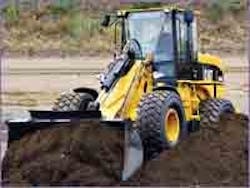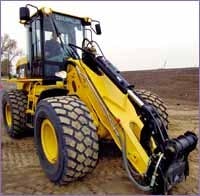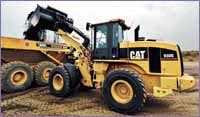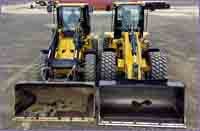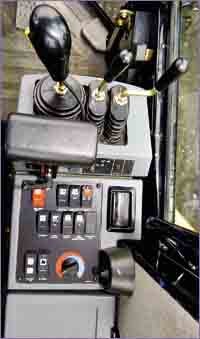Double-Duty for Cat's 930G Wheel Loader
Caterpillar's new 149-hp 930G is an interesting addition to the company's wheel-loader range. First, it's a new size, positioned between the 143-hp 928G and the 160-hp 938G. Interesting, too, is that it replaces the IT28G, the "Integrated Tool-Carrier" counterpart of the 928G. It's as if Caterpillar expects this new model to do double-duty—that is, to work as a conventional wheel loader in that space between the 928G and 938G, yet meet the requirements of buyers needing a tool carrier in that size class.
The situation is similar to Cat's replacing both the 924F and the IT24F with the 924G some four years ago. Construction Equipment conducted a field test of these three models (published June 2000), and concluded that the 924G could not only outwork its predecessors significantly at routine bucket work, but also its loader geometry and lift capacity would allow it to function efficiently as a tool carrier.
The working end of the 930G reflects the same design as that of the 924G. It has a single, fabricated boom arm, centered on the machine's front frame, together with an eight-bar, parallel-lift linkage. This "VersaLink" loader system, says Cat, is designed to blend the parallel-lift and attachment-handling capabilities of a tool-carrier with the digging strength and speed of a conventional wheel loader using six-bar (Z-bar) linkage.
Caterpillar graciously loaned us one of its field-follow machines for this installment of Hands-On Earthmoving. As always, the site was the Apprenticeship and Skill Improvement facility that Local 150 (International Union of Operating Engineers) maintains in Plainfield, Ill. The 930G arrived with its optional attachment coupler, a 3-cubic-yard general-purpose bucket and 600/65R25 XLD L3 Michelin tires. Local 150 instructor, Jim Minyard, was our operator for the evaluation.
Minyard had worked the 930G a bit before we arrived on the day of the evaluation, so we asked the obvious first question:
Jim, did you corner-load the bucket to see if it twists at the end of that single boom arm?
He said no, but now that we had planted the idea, he might try it. Actually, when working with Caterpillar on the 924G test, we were told that deflection at the bucket corners is, in fact, less with the VersaLink system for a given load, than with conventional loader linkage. In the half-day or so that Minyard worked the 930G, bucket stability was never an issue.
We were curious to get Minyard's initial impressions of the machine, and asked if any of its features stood out in his short time at the controls.
"My first thought was how well you can see the bucket—the corners, and even the bottom. Sight lines are good. The visibility, I think, is much improved over that of the IT28 in our fleet."
Anything else you noticed?
"The loader controller. It fits your hand nicely, and it has a forward/reverse switch and a kick-down button that I find handy. When I used the kick-down, the only indication that the machine had shifted was that it had more power. Directional shifts are also smooth—no banging or head jerking—even when you don't use the brakes."
(Electronic control of clutch engagement modulates the pressure rise in the 930G's clutch packs, bringing the clutches to full engagement gradually—relatively speaking—and smoothly.
Minyard then took the new loader out to local 150's 80-acre site for some routine bucket work, and we asked him to experiment with the machine's dual-mode steering system. This optional steering system can be switched between conventional steering (three to four turns, lock-to-lock) and a "Quick-Steer" mode, which provides lock-to-lock steering in about 50 degrees of steering-wheel rotation.
Minyard's exercise with the new machine included loading a Volvo articulated truck; carrying material up a reasonably steep grade to simulate hopper charging; taking a few high-speed load-and-carry passes; and excavating from a tightly compacted bank, then building a large stockpile of loose material, which he subsequently pushed through and carried back to the bank.
"The machine has a tremendous amount of pushing power," he said, "but I noticed that there was no differential-lock button. Just for an instant, I detected a bit of wheel spin, but then all four tires seemed to grip and it moved through the pile with no problem."
(According to Caterpillar, the limited-slip feature of the axles would account for Minyard's observation.)
How would you rate its hydraulic power?
"Excellent, both bucket breakout and boom lift. I've been on some new loaders recently that seem a little weak in boom lift. I never had to wait on the boom."
(The 930G is equipped with a load-sensing hydraulic system that uses a variable-displacement pump. According to Caterpillar, the new system is stronger and smoother than that of the IT28G, and its design saves fuel.)
How did you get along with Quick-Steer?
"I spilled a lot of material at first, because it takes a few cycles to get the hang of how fast the system reacts. But I think it's an excellent feature. I can remember going home some nights with the muscles in my arm burning from cranking a steering wheel around all day."
Any comments about its load-and-carry performance?
"About what I expected. It has a lot of power on grades, and the ride-control makes a real difference."
During coffee, before Minyard put the 930G to work, we gave him a page from the operator's manual that explained the operation of the transmission-neutralizer. We asked him to experiment with the new system, which can be switched on and off, and can be programmed to activate at varying points in the brake-application cycle.
(For instance, set at a high pressure, say 400 psi, the transmission would not disconnect until the brakes were nearly full on and, conversely, would reconnect quickly as the brakes were released. This setting could be advantageous, says Caterpillar, for controlling rollback when charging a hopper from a steep ramp.)
So what did Minyard think?
"I like having the option of being able to turn off the neutralizer, because even though it's a good feature, there are some situations where I think it's a hindrance. As far as being able to adjust the system, I think I understand what Cat is trying to do—and it's a good idea. There are situations where you'd want the machine to roll a bit with the transmission disconnected—for instance, to bring up engine speed for faster hydraulics. But on inclines, you'd want more holding power."
How would you sum up the overall performance of the machine?
"It's comfortable to operate and has plenty of power. I would assume, too, that its parallel linkage would make it good at handling forks and attachments."
